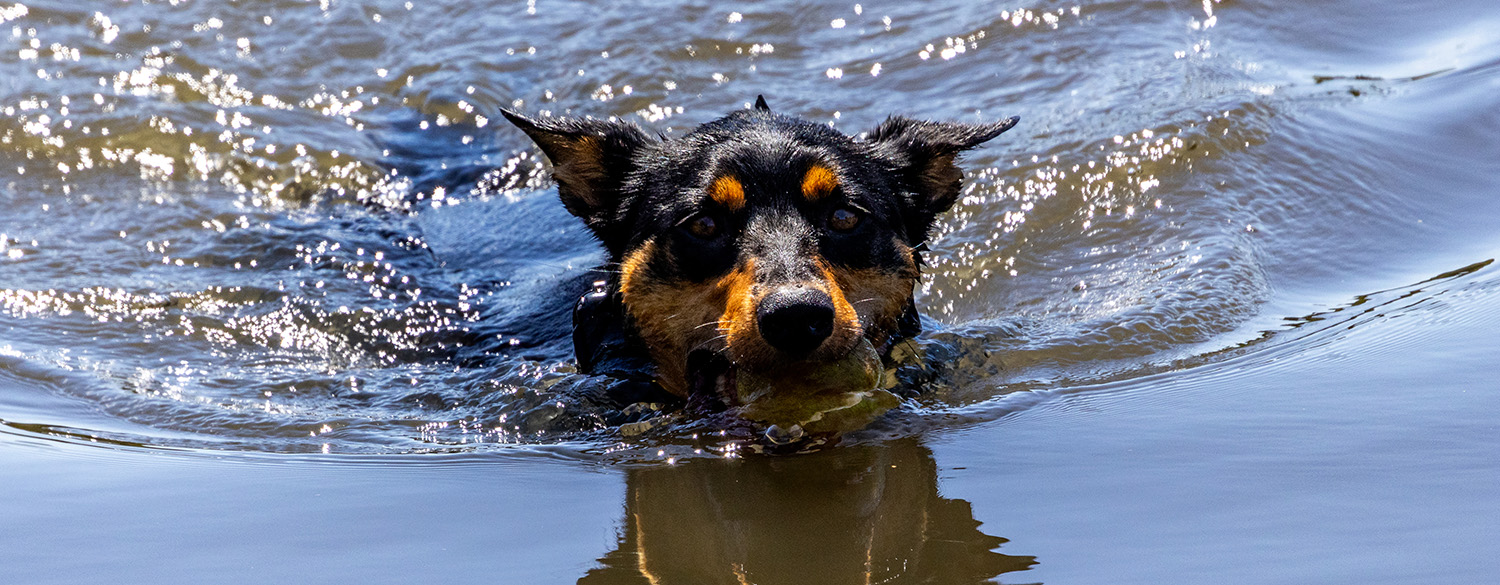
Heading down to the beach or out on the boat with your best mate (two and four legged) is one of summer’s highlights. Taking your dog for a swim can be beneficial for both their mental and physical well-being. While not all dogs are natural swimmers, you can teach them how to swim and ensure their safety whether you’re at the beach, lake, or pool.
Follow these essential tips to ensure that your furry friend can swim happily and safely.
- Provide your dog with a life vest: A life vest for dogs is an essential item to have in your pet emergency kit as it guarantees their safety in deep water. There are various options available in the market, but the most important factor is finding one that fits properly and prevents slipping while floating. Every dog, especially breeds that struggle with swimming like bulldogs, should have a life jacket. While any snug-fitting life vest can help them float, consider additional features such as:
Coverage: Opt for a life jacket that covers more of your dog’s body, making them more visible, which is ideal for swimming in lakes and oceans. However, if your dog will be swimming in a family pool, a basic life vest should suffice
Handle: Having a handle on your dog’s life vest makes it easier to grab and lift them out of the water when necessary. It also helps in teaching them to swim as you can keep them afloat and guide them in the water
D-ring: If you plan on taking your dog on a boat or any other watercraft, it is important to have them securely leashed to prevent them from jumping off. Ensure that their life vest has a D-ring for this purpose. Additionally, keeping your dog leashed in public areas is ideal to prevent them from running off.
- Start slowly: Introduce your dog to water gradually, as you may not be aware of their swimming ability. If it’s their first time at the beach or a lake, find a calm area with warm water to help them feel more comfortable. Similarly, if you’re introducing them to your pool, start at the shallow end near the stairs. Some dogs may show immediate interest in getting into the water, while others may need some encouragement. Use treats and walk along the shallow edges, gradually allowing them to venture deeper.
- Teach your dog to swim: Not all dogs are naturally inclined to swim, and certain breeds may find it more challenging to stay afloat or swim due to their physical characteristics. For instance, breeds like Dachshunds and Corgis with short legs may face difficulties. After your dog has become familiar with the water, you can slowly teach them to swim using toys, treats, or by calling their name. Always start in shallow water and remain close to your dog in case they panic. If they are comfortable and enjoying themselves, encourage them to step off into deeper water and swim towards a treat. Some dogs may require assistance and may feel scared, so be patient and supportive. If your dog is hesitant to step off the edge, you can try carrying them further into the water and hold them while they swim. It’s important to understand that not all dogs are natural swimmers, and if they are not interested or seem stressed, there is no need to force them. Pay attention to your dog’s body language to gauge their comfort level, and never compel them to swim if they prefer staying in shallow water.
- Join them in the water: Staying close to your dog is essential to ensure their safety. It is crucial to equip them with a life vest that includes a handle and ensure they are always within arm’s reach if they aren’t confident in the water. Some dogs may feel anxious while swimming, which can lead to panic. Additionally, certain dogs may need assistance in getting out of the water if they are not fond of swimming initially. By being in the water with your pooch, you can maintain close proximity and promptly respond to any unforeseen circumstances, thus guaranteeing their safety.
- Never Leave your dog unattended: Never let your dog do in deep waters, irrespective of their swimming capabilities. Even if your dog is an excellent swimmer, it is vital to stay within proximity to keep a close eye on them and help if needed. For instance, if your dog is swimming in a pool, it is advisable to be outside, supervising their activities to ensure their safety.
- Take regular breaks: Your dog will need time away from the water to relieve themselves and conserve energy. If you are on a watercraft such as a boat, it is important to plan your activities around your dog’s usual schedule. Swimming requires more exertion than running, so it is essential to pay attention to your dog’s condition and provide them with ample rest. Dogs cannot communicate when they are exhausted, making it important for you to be observant and attentive to their needs.
- Know canine CPR: having basic first aid skills can be instrumental in safeguarding your beloved pet. Knowing life-saving techniques such as the Heimlich manoeuvre for a choking dog and CPR for drowning dogs can be life-saving. Canine CPR closely resembles human CPR. If your dog submerges in water and stops breathing, it is important to immediately move them to dry land or a boat and assess their breathing and heartbeat. Once you have confirmed that your dog is still alive, you can initiate chest compressions by firmly and rapidly pressing the heel of one hand on their chest. Additionally, administer rescue breaths by opening their airway, covering their nose with your mouth, and exhaling until you notice their chest rising. Continue this process until they regain their ability to breathe independently. Seeking veterinary assistance as soon as possible is recommended to ensure comprehensive care for your dog. Although CPR can be effective, veterinarians possess the necessary tools and expertise to handle such situations.
- Provide clean drinking water: Swimming is very physically demanding, and some dogs may be tempted to drink from pools, lakes, or oceans when they are thirsty, so it is crucial to carry fresh water with you at all times. To facilitate this, you can use a portable dog bowl and water bottle to ensure your dog always has access to clean water. If your dog is drinking excessive amounts of water, it may indicate that they are overexerting themselves in the sun and becoming dehydrated. It is important to provide them with a resting place when they are tired from swimming.
- Rinse and dry off your dog: Pool water contains chlorine, which can cause skin problems for both dogs and humans. Lakes and oceans may also contain pollutants that can affect your dog’s skin and coat. Rinsing your dog will help remove any debris, such as algae, from their fur and eliminate any chemicals or harmful substances from their skin. While your dog may shake off excess water, using a towel can speed up the drying process. Additionally, it is important to check your dog’s ears after swimming, as moisture can lead to ear infections. By using specific dog care products, you can prevent such infections by applying a few drops to your dog’s ears, allowing the drying agent in the solution to remove any excess water.
- Know the signs of water intoxication in dogs: This rare condition occurs when a dog ingests an excessive amount of water, leading to a dilution of electrolytes in their bloodstream. This can potentially cause brain swelling and seizures. Water intoxication is more of a concern during the summer months when dogs tend to drink more water or spend time in bodies of water. Additionally, saltwater intoxication can occur when a dog consumes too much saltwater, resulting in an imbalance that pulls water from their brain cells.
Signs of water intoxication can include:
- Nausea
- Vomiting
- Lethargy
- Distention (Bloating)
Pool Safety
Teaching your dog how to exit a pool is just as important as teaching them how to swim. It is crucial to fence off the pool when you are unable to supervise your dog’s swimming activities, as it can be risky for them to be in the water alone. This precaution is necessary because pool covers can potentially trap dog’s underneath, even if they are strong swimmers, leading to drowning incidents. It is also advisable to prevent your dog from drinking pool water, as the majority of the chemicals used are not harmful to dogs, but high levels of chlorine can irritate their skin and cause respiratory problems known as pool shock. If your dog experiences pool shock, they may collapse after swimming and require intravenous supportive care to eliminate the chlorine from their system.
Beach Safety
When planning a trip to the beach with your furry friend, it is important to be aware of the conditions and act accordingly. Always check for unsafe water conditions, such as large waves or rips that could pull your dog into deep water. Additionally, make sure the water temperature is warm enough for both you and your dog to swim comfortably. It is important to prevent your dog from drinking saltwater, as it can lead to symptoms like diarrhea or even be fatal depending on the amount consumed. Drinking excessive amounts of saltwater can result in dehydration and disrupt the fluid balance in your dog’s system, and too much sodium can be lethal. If your dog ingests any kind of ocean or saltwater, it is advisable to take them to your vet immediately for treatment, as you may not know the extent of their consumption. While swimming in the ocean with your dog, it is important to prevent them from interacting with marine life, as some of these creatures can cause serious harm to your pet. Additionally, ensure that the beach you choose is dog-friendly and follow any regulations regarding dogs being off-leash, as some local beaches may have restrictions.
Lake and River Safety
When taking your dog to lakes and rivers, it is essential to be aware of the presence of blue-green algae, which thrives in warm and stagnant water. This type of algae is toxic to dogs and can lead to liver necrosis and shock within a few hours if ingested. The best way to protect your dog from harmful algae is to closely monitor them while they are swimming and prevent them from drinking any water from lakes or rivers. It is also advisable to only allow your dog to swim in clear moving water, as the likelihood of algae presence is lower in such conditions.

